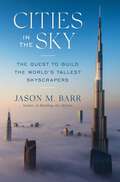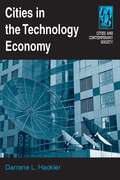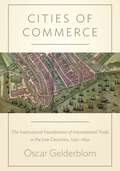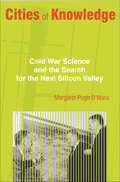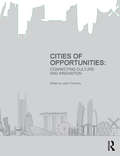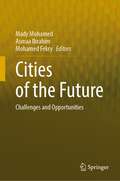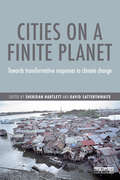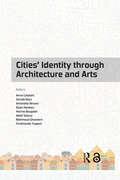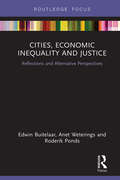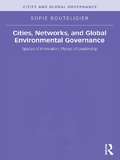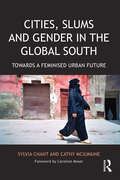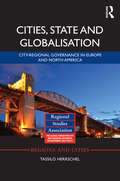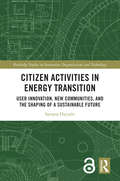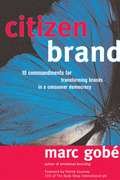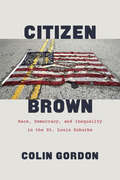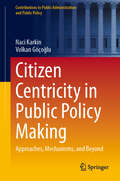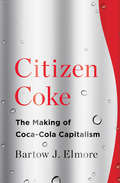- Table View
- List View
Cities in a Time of Terror: Space, Territory, and Local Resilience (Cities And Contemporary Society Ser.)
by H.V. SavitchThis book is about urban terror - its meaning, its ramifications, and its impact on city life. Written by a well-known expert in the field, "Cities in a Time of Terror" draws on data from more than a thousand cities across the globe and traces the evolution of urban terrorism between 1968 and 2006. It explains what kinds of cities have become prime targets, why terrorism has become increasingly lethal, and how its inspiration has changed from secular to religious. The author describes urban terrorism as an attempt to use the city's own strength against itself, forcing it to implode, and delineates three basic logics of terrorist choices for targeting cities. The book also includes a discussion of local resilience - the city's capacity to bounce back from attack - and suggests how that can be sustained. Examples from New York, London, Jerusalem, Istanbul, Moscow, Paris, and Madrid illustrate the book's central themes.
Cities in the Sky: The Quest to Build the World's Tallest Skyscrapers
by Jason M. BarrFrom one of the world&’s top experts on the economics of skyscrapers—a fascinating account of the ever-growing quest for super tall buildings across the globe.The world&’s skyscrapers have brought us awe and wonder, and yet they remain controversial—for their high costs, shadows, and overt grandiosity. But, decade by decade, they keep getting higher and higher. What is driving this global building spree of epic proportions? In Cities in the Sky, author Jason Barr explains all: why they appeal to cities and nations, how they get financed, why they succeed economically, and how they change a city&’s skyline and enable the world&’s greatest metropolises to thrive in the 21st century. From the Empire State Building (1,250 feet) to the Shanghai Tower (2,073 feet) and everywhere in between, Barr explains the unique architectural and engineering efforts that led to the creation of each. Along the way, Barr visits and unpacks some surprising myths about the earliest skyscrapers and the growth of American skylines after World War II, which incorporated a new suite of technologies that spread to the rest of the world in the 1990s. Barr also explores why London banned skyscrapers at the end of the 19th century but then embraced them in the 21st and explains how Hong Kong created the densest cluster of skyscrapers on the planet. Also covered is the dramatic result of China&’s &“skyscraper fever&” and then on to the Arabian Peninsula to see what drove Dubai to build the world&’s tallest building, the Burj Khalifa, which at 2,717 feet, is higher than the new One World Trade Center in New York by three football fields. Filled with fascinating details for urbanists, architecture buffs, and urban design enthusiasts alike, Cities in the Sky addresses the good, bad, and ugly for cities that have embraced vertical skylines and offers us a glimpse to the future to see whether cities around the world will continue their journey ever upwards.
Cities in the Technology Economy
by Darrene HacklerRecognizing the pivotal role that local governments play in the high-tech economy, this book examines the effect of technology industries and infrastructures on cities and the local policy actions required for effective response to these challenges. Filled with fresh information and practical advice, "Cities in the Technology Economy" provides a thorough coverage of the technology economy with respect to cities and economic development, focusing on the attraction of technology industries and investment in technology infrastructure. The author utilizes a triangualtion of approaches - national level data, nationwide survey of local officials, and case studies - to examine what cities are doing in the technology economy, describe the barriers to participation in the technology economy, and detail entrepreneurial actions of local governments to traverse these hurdles. All of the research points to the need for a strong local role enabling local policy action and activities to shape a technology economy response.
Cities of Commerce: The Institutional Foundations of International Trade in the Low Countries, 1250-1650 (The Princeton Economic History of the Western World #45)
by Oscar GelderblomCities of Commerce develops a model of institutional change in European commerce based on urban rivalry. Cities continuously competed with each other by adapting commercial, legal, and financial institutions to the evolving needs of merchants. Oscar Gelderblom traces the successive rise of Bruges, Antwerp, and Amsterdam to commercial primacy between 1250 and 1650, showing how dominant cities feared being displaced by challengers while lesser cities sought to keep up by cultivating policies favorable to trade. He argues that it was this competitive urban network that promoted open-access institutions in the Low Countries, and emphasizes the central role played by the urban power holders--the magistrates--in fostering these inclusive institutional arrangements. Gelderblom describes how the city fathers resisted the predatory or reckless actions of their territorial rulers, and how their nonrestrictive approach to commercial life succeeded in attracting merchants from all over Europe. Cities of Commerce intervenes in an important debate on the growth of trade in Europe before the Industrial Revolution. Challenging influential theories that attribute this commercial expansion to the political strength of merchants, this book demonstrates how urban rivalry fostered the creation of open-access institutions in international trade.
Cities of Knowledge: Cold War Science and the Search for the Next Silicon Valley (Politics and Society in Modern America)
by Margaret Pugh O'MaraWhat is the magic formula for turning a place into a high-tech capital? How can a city or region become a high-tech powerhouse like Silicon Valley? For over half a century, through boom times and bust, business leaders and politicians have tried to become "the next Silicon Valley," but few have succeeded. This book examines why high-tech development became so economically important late in the twentieth century, and why its magic formula of people, jobs, capital, and institutions has been so difficult to replicate. Margaret O'Mara shows that high-tech regions are not simply accidental market creations but "cities of knowledge"--planned communities of scientific production that were shaped and subsidized by the original venture capitalist, the Cold War defense complex. At the heart of the story is the American research university, an institution enriched by Cold War spending and actively engaged in economic development. The story of the city of knowledge broadens our understanding of postwar urban history and of the relationship between civil society and the state in late twentieth-century America. It leads us to further redefine the American suburb as being much more than formless "sprawl," and shows how it is in fact the ultimate post-industrial city. Understanding this history and geography is essential to planning for the future of the high-tech economy, and this book is must reading for anyone interested in building the next Silicon Valley.
Cities of Opportunities: Connecting Culture and Innovation
by Jason PomeroyCulture refers to not only the arts but also other manifestations of human intellectual achievement regarded collectively. It similarly refers to the customs, institutions, and achievements of a social group, a people, or a nation. Innovation refers to the action or process of change, alteration, or revolution; a new method of idea creation or product that may bring about change. It is easy to assume that innovation may be juxtaposed to the preservation of culture and time-tested rituals. Yet as human settlements grew; and as streets and squares evolved through the diverse exchanges of people trading, celebrating, rallying and socially interacting, it should come as little surprise that cities and its places would become, and continue to be, centres of culture and innovation that can be inextricably linked. Culture and Innovation in cities can potentially take on different complexions if viewed through the lens of academics and practitioners drawn from different geographies, disciplines, or fields of expertise when addressing particular urban challenges. It is through this complexity of views that this book seeks to provide a broad perspective on culture and innovation in the context of global cities today; and a rich cornucopia of insights from thought leaders within their respective fields to shape the cities of tomorrow.
Cities of the Future: Challenges and Opportunities
by Asmaa Ibrahim Mady Mohamed Mohamed FekryThis book seeks to address the key challenges and opportunities of "future cities" embracing novel approaches and grounded technologies in pursuing a vision for smart, inclusive cities. The objective of this book is to discuss multiple areas at the local, national, and international levels and how these challenges can hinder the development objectives planned to be achieved by the cities of the future. The chapters featured in this collection were presented at the 6th Memaryat International Conference (MIC 2022), held at the Effat University, Jeddah. MIC’s objective is to build bridges between science, technology, and innovation, seen as the key levers of attaining the SDGs.This book provides the most innovative ideas presented at the conference to address the key manifestation of “future cities" to embrace novel approaches and grounded technologies in the pursue of a vision for smart inclusive cities. It thus represents a platform for diverse contributions from academics and practitioners to present their different perspectives addressed theoretically as well as in practice concerning the challenges and opportunities of future cities. This includes contributions from decision-makers, architects, urban planners, urban designers, entrepreneurs, and educators to stimulate discussion covering the latest on the challenges and opportunities for better future cities in the different domains of architecture, building science and technology, environmental design, mobility & infrastructure, urban design & landscape, housing & real estate developments, urban planning, governance, socio-cultural & economic development, community engagement, tourism and heritage revitalization.
Cities on a Finite Planet: Towards transformative responses to climate change
by David Satterthwaite Sheridan BartlettCities on a Finite Planet: Transformative responses to climate change shows how cities can combine high quality living conditions, resilience to climate change, disaster risk reduction and contributions to mitigation/low carbon development. It also covers the current and potential contribution of cities to avoiding dangerous climate change and is the first book with an in-depth coverage of how cities and their governments, citizens and civil society organizations can combine these different agendas, based on careful city-level analyses. The foundation for the book is detailed city case studies on Bangalore, Bangkok, Dar es Salaam, Durban, London, Manizales, Mexico City, New York and Rosario. Each of these was led by authors who contributed to the IPCC’s Fifth Assessment and are thus acknowledged as among the world’s top specialists in this field. This book highlights where there is innovation and progress in cities and how this was achieved. Also where there is little progress and no action and where there is no capacity to act. It also assesses the extent to which cities can address the Sustainable Development Goals within commitments to also dramatically reduce greenhouse gas emissions. In this, it highlights how much progress on these different agendas depends on local governments and their capacities to work with their low-income populations.
Cities' Identity Through Architecture and Arts: Proceedings of the International Conference on Cities' Identity through Architecture and Arts (CITAA 2017), May 11-13, 2017, Cairo, Egypt (Advances in Science, Technology & Innovation)
by Hocine Bougdah Anna Catalani Zeinab Nour Antonella Versaci Dean Hawkes Adolf Sotoca Mahmoud Ghoneem Ferdinando TrapaniEvery city has its unique and valuable identity, this identity is revealed through its physical and visual form, it is seen through the eyes of its residents and users. The city develops over time, and its identity evolves with it. Reflecting the rapid and constant changes the city is subjected to, Architecture and Arts, is the embodiment of the cultural, historical, and economical characteristics of the city. This conference was dedicated to the investigation of the different new approaches developed in Architecture and Contemporary arts. It has focused on the basis of urban life and identities. This volume provides discussions on the examples and tendencies in dealing with urban identities as well as the transformation of cities and urban cultures mentioned in terms of their form, identity, and their current art. Contemporary art, when subjected to experiments, continues to be produced in various directions, to be consumed and to put forward new ideas. Art continuously renews itself, from new materials to different means of communication, from interactive works to computer games, from new approaches to perceptional paradigms and problems of city and nature of the millennium. This is an Open Access ebook, and can be found on www.taylorfrancis.com.
Cities, Economic Inequality and Justice: Reflections and Alternative Perspectives (Routledge Focus on Economics and Finance)
by Edwin Buitelaar Anet Weterings Roderik PondsIncreasing economic inequality in cities, and the spatial translation of that into more segregated neighbourhoods, is top of the political agenda in developed countries. While the overall living standards have increased in the last century, the focus has now shifted from poverty to economic differences, with a particular focus on the gap between the very poor and the (ultra-)rich. The authors observe a common view among policy-makers and researchers alike: that urban-economic inequality and segregation are increasing; that this increase is bad; and that money and people (in the case of segregation) need to be redistributed in response. In six compact chapters, this book enriches and broadens the debate. Chapters bring together the literature on the social effects of economic inequality and segregation and question whether there are sizable effects and what their direction (positive or negative) is. The often conflated concepts of economic inequality (and segregation) and social injustice is disentangled and the moral implications are reflected on. The book is essential reading for students and academics of Planning Theory, Planning Ethics, Urban Geography, Urban Economics, Economic Geography and Urban Sociology.
Cities, Networks, and Global Environmental Governance: Spaces of Innovation, Places of Leadership (Cities and Global Governance)
by Sofie BouteligierAs a result of global dynamics—the increasing interconnection of people and places—innovations in global environmental governance haved altered the role of cities in shaping the future of the planet. This book is a timely study of the importance of these social transformations in our increasingly global and increasingly urban world. Through analysis of transnational municipal networks, such as Metropolis and the C40 Cities Climate Leadership Group, Sofie Bouteligier's innovative study examines theories of the network society and global cities from a global ecology perspective. Through direct observation and interviews and using two types of city networks that have been treated separately in the literature, she discovers the structure and logic pertaining to office networks of environmental non-governmental organizations and environmental consultancy firms. In doing so she incisively demonstrates the ways in which cities fulfill the role of strategic sites of global environmental governance, concentrating knowledge, infrastructure, and institutions vital to the function of transnational actors.
Cities, Slums and Gender in the Global South: Towards a feminised urban future (Regions And Cities Ser.)
by Sylvia Chant Cathy McIlwaineDeveloping regions are set to account for the vast majority of future urban growth, and women and girls will become the majority inhabitants of these locations in the Global South. This is one of the first books to detail the challenges facing poorer segments of the female population who commonly reside in ‘slums’. It explores the variegated disadvantages of urban poverty and slum-dwelling from a gender perspective. This book revolves around conceptualisation of the ‘gender-urban-slum interface’ which explains key elements to understanding women’s experiences in slum environments. It has a specific focus on the ways in which gender inequalities are can be entrenched but also alleviated. Included is a review of the demographic factors which are increasingly making cities everywhere ‘feminised spaces’, such as increased rural-urban migration among women, demographic ageing, and rising proportions of female-headed households in urban areas. Discussions focus in particular on education, paid and unpaid work, access to land, property and urban services, violence, intra-urban mobility, and political participation and representation. This book will be of use to researchers and professionals concerned with gender and development, urbanisation and rural-urban migration.
Cities, State and Globalisation: City-Regional Governance in Europe and North America (Regions and Cities #70)
by Tassilo HerrschelThis book investigates the ways in which city regions view themselves as single entities, how they are governed, what is meant by ‘governance’, why the question of city-regional governance matters, and the extent to which the balance between internal and external factors is important for finding governance solutions. Examples from North America and Europe are compared and contrasted to gain a better understanding of what matters ‘on the ground’ to people and policy makers when seeking answers to the challenges of a globalised, rapidly changing world. In order to analyse the conditions involved in making local decisions, the author looks at the impact of established policy-making practices, socio-economic patterns among the population, existing views of the ‘local’ and the ‘regional’ and their respective roles among the electorate and policy makers, and the scope for building city-regional governance under given statutory and fiscal provisions. The complex interaction of these factors is shown to produce place-specific forms and modi operandi for governing city regions as local-regional constructs. This book will be of interest to urban and regional policy makers and scholars working in the fields of economic geography and political geography.
Citigroup 2007: Financial Reporting and Regulatory Capital
by Edward J. Riedl Suraj Srinivasan Sharon KatzCase
Citigroup Technology Infrastructure Division: Financial Strategies for Managing IT as a Business Within a Business
by Robert S. Kaplan Steven R. AndersonThis chapter illustrates how using TDABC to create an activity-based Business Performance Management (BPM) system helped the Citigroup Technology Infrastructure Division--an internal shared services division--to operate as a "business within a business."
Citigroup's Exchange Offer
by James Quinn Robin GreenwoodCitigroup faced considerable distress in early 2009. In late 2008, the bank had accepted $45 billion in preferred equity from the United States government via the Troubled Assets Relief Program (TARP). Yet, the stock had continued to slide in early 2009. In late February, the company announced that it would convert as much as $50 billion of preferred stock into common stock, at $3.25 per share. The case asks students to evaluate the pricing of preferred stock relative to common stock at this time. As the case takes place during a period of considerable uncertainty in global capital markets, and conventional sources of arbitrage capital have been depleted, the apparent mispricing may not be as attractive as it initially seems. In the B and C cases, students must decide whether their view of the appropriate pricing changes, when the apparent mispricing worsens. A final additional teaching point relates to the formation of a synthetic short position using the options markets.
Citizen Activities in Energy Transition: User Innovation, New Communities, and the Shaping of a Sustainable Future (Routledge Studies in Innovation, Organizations and Technology)
by Sampsa HyysaloThis book addresses the rapidly changing citizen roles in innovation, technology adoption, intermediation, market creation, and legitimacy building for low-carbon solutions. It links research in innovation studies, sustainability transitions, and science and technology studies, and builds a new approach for the study of user contributions to innovation and sociotechnical change. Citizen Activities in Energy Transition gives detailed and empirically grounded overall appraisal of citizens’ active technological engagement in the current energy transition, in an era when Internet connectivity has given rise to important new forms of citizen communities and interactions. It elaborates a new way to study users in sociotechnical change through long-term ethnographic and historical research and reports its deployment in a major, decade-long line of investigation on user activities in small-scale renewables, addressing user contributions from the early years to the late proliferation stages of small-scale renewable energy technologies (S-RETs). It offers a much-needed empirical and theoretical understanding of the dynamics of the activities in which users are engaged over the course of sociotechnical change, including innovation, adoption, adjustment, intermediation, community building, digital communities, market creation, and legitimacy creation. This work is a must-read for those seeking to understand the role of users in innovation, energy systems change and the significance of new digital communities in present and future sociotechnical change. Academics, policymakers, and managers are given a new resource to understand the "demand side" of sociotechnical change beyond the patterns of investment, adoption, and social acceptance that have traditionally occupied their attention.
Citizen Brand: 10 Commandments for Transforming Brands in a Consumer Democracy
by Marc GobeLeading brand designer Marc Gobé builds on his highly successful Emotional Branding strategy with Citizen Brand, a powerful new concept designed to help companies earn the trust of today's consumers. Gobé argues that corporations need a new vision to survive in the present "emotional economy," challenging them to develop more passionate, human, and socially responsible brand strategies. He shows how to transform Consumers to People, Products to Experiences, Honesty to Trust, Quality to Preference, Identity to Personality, and Service to Relationship.
Citizen Brown: Race, Democracy, and Inequality in the St. Louis Suburbs
by Colin GordonA study of the 2014 killing in Ferguson: “Pioneering . . . A larger, more complicated consideration of the recent history of race relations in American suburbs.” —Mark Krasovic, author of The Newark FrontierThe killing of Michael Brown in Ferguson, Missouri, ignited nationwide protests and brought widespread attention to police brutality and institutional racism. As Colin Gordon shows in this book, the events in Ferguson didn’t just expose the deep racism of a local police department—it also revealed the ways in which decades of public policy effectively segregated people and curtailed citizenship not just in Ferguson but across the St. Louis suburbs.Citizen Brown uncovers half a century of private practices and public policies that resulted in bitter inequality and sustained segregation in Ferguson and beyond. Gordon shows how municipal and school district boundaries were pointedly drawn to contain or exclude African Americans and how local policies and services—especially policing, education, and urban renewal—were weaponized to maintain civic separation. He also makes it clear that the outcry that arose in Ferguson was no impulsive outburst but rather an explosion of pent-up rage against long-standing systems of segregation and inequality—of which a police force that viewed citizens not as subjects to serve and protect but as sources of revenue was only the most immediate example. Worse, Citizen Brown illustrates the fact that though the greater St. Louis area provides some extraordinarily clear examples of fraught racial dynamics, in this it is hardly alone among American cities and regions.“[An] innovative study . . . Citizen Brown also benefits from being grounded in political theory about citizenship and its many meanings.” —Missouri Historical Review
Citizen Capitalism: How A Universal Fund Can Provide Influence and Income To All
by Lynn Stout Tamara Belinfanti Sergio GramittoCorporations have a huge influence on the life of every citizen--this book offers a visionary but practical plan to give every citizen a say in how corporations are run while also gaining some supplemental income. It lays out a clear approach that uses the mechanisms of the private market to hold corporations accountable to the public. This would happen through the creation of what the authors call the Universal Fund, a kind of national mega fund. Every American over eighteen would be entitled to a share and would participate in directing its share voting choices. Corporations and wealthy individuals would donate stocks, bonds, cash, or other assets to the fund just like they do to other philanthropic ventures now. The fund would pay out dividends to its citizen-shareholders that would grow as the fund grows. The Universal Fund is undoubtedly a big idea, but it is also eminently practical: it uses the tools of capitalism, not government, to give all citizens a direct influence on corporate actions. It would be a major institutional investor beholden not to a small elite group of stockholders pushing for short-term gain but to everyone. The fund would reward corporations that made sure their actions didn't harm people, communities, and the environment, and it would enable them to invest in innovations that would take more than a few months to pay off. Which is another reason corporations would donate to the fund--they could be freed from the constant pressure to maximize their quarterly share price and would essentially be subsidized for doing good. The authors demonstrate that our current economic rules force corporations to be shortsighted and even destructive because for most large investors, nothing matters but share price. The Universal Fund is designed to be a powerful positive balancing force, making the world a better place and the United States a better nation.
Citizen Centricity in Public Policy Making: Approaches, Mechanisms, and Beyond (Contributions to Public Administration and Public Policy)
by Volkan Göçoğlu Naci KarkinThe book explores and positions citizen centricity within conventional public administration and public policy analysis theories and approaches. It seeks to define an appropriate perspective while utilizing popular, independent, and standalone concepts from the literature that support citizen centricity. Additionally, it illustrates the implementation part with practical cases. It ultimately presents a novel and descriptive approach to provide insights into how citizen centricity can be applied in practice. This descriptive novel approach has three essential components: a base and two pillars. The foundation includes new-age public policy making approaches and complexity theory. The first column reflects the conceptual dimension, which comprises supporting concepts from the literature on citizen centricity. The second column represents the practical dimension, a structure supported by academic research that provides practical cases and inspiration for future applications. The descriptive novel approach accepts citizen centricity as a fundamental approach in public policy making and aims to create a new awareness in the academic community on the subject. Additionally, the book provides refreshed conceptual and theoretical backgrounds, along with tangible participatory models and frameworks, benefiting academics, professionals, and graduate students.
Citizen Charter and Local Service Delivery in Bangladesh
by Pranab Kumar Panday Shuvra ChowdhuryThis book illuminates the importance of the citizen charter (CC) in local service delivery in Bangladesh. It describes how CC was implemented into the service delivery process and its impact. In the 1970s, the transition from traditional public administration to new public management was inspired by globalization, the emergence of an information and technological society, and many economic theories, such as public choice, principal-agent theory, and transaction cost. The purpose of the government in a welfare state is to serve the citizens by providing essential services. However, public service delivery in most developing nations is ineffective owing to corruption, waste of public funds, a lack of responsibility on the part of public employees, etc. In this context, CC emerged as a means of educating individuals on many elements of services, so they may hold service providers accountable. Thus, the issue of framing and implementation of CC has been put in place due to the persistent pressing of academicians, politicians, and practitioners advocating for better local service delivery.
Citizen Coke: The Making of Coca-Cola Capitalism
by Bartow J. ElmoreAn absorbing history of how Coke's insatiable thirst for natural resources shaped the company and reshaped the globe. How did Coca-Cola build a global empire by selling a low-price concoction of mostly sugar, water, and caffeine? The easy answer is advertising, but the real formula to Coke's success was its strategy, from the start, to offload costs and risks onto suppliers, franchisees, and the government. For most of its history the company owned no bottling plants, water sources, cane- or cornfields. A lean operation, it benefited from public goods like cheap municipal water and curbside recycling programs. Its huge appetite for ingredients gave it outsized influence on suppliers and congressional committees. This was Coca-Cola capitalism. In this new history Bartow J. Elmore explores Coke through its ingredients, showing how the company secured massive quantities of coca leaf, caffeine, sugar, and other inputs. Its growth was driven by shrewd leaders such as Asa Candler, who scaled an Atlanta soda-fountain operation into a national empire, and "boss" Robert Woodruff, who nurtured partnerships with companies like Hershey and Monsanto. These men, and the company they helped build, were seen as responsible citizens, bringing jobs and development to every corner of the globe. But as Elmore shows, Coke was usually getting the sweet end of the deal. It continues to do so. Alongside Coke's recent public investments in water purification infrastructure, especially in Africa, it has also built--less publicly--a rash of bottling plants in dangerously arid regions. Looking past its message of corporate citizenship, Elmore finds a strategy of relentless growth. The costs shed by Coke have fallen on the public at large. Its annual use of many billions of gallons of water has strained an increasingly scarce global resource. Its copious servings of high-fructose corn syrup have threatened public health. Citizen Coke became a giant in a world of abundance. In a world of scarcity it is a strain on resources and all who depend on them.
Citizen Designer: Perspectives on Design Responsibility (Second Edition)
by Steven Heller Veronique VienneBalancing Social, Professional, and Artistic Views What does it mean to be a designer in today's corporate-driven, overbranded global consumer culture? Citizen Designer, Second Edition, attempts to answer this question with more than seventy debate-stirring essays and interviews espousing viewpoints ranging from the cultural and the political to the professional and the social. This new edition contains a collection of definitions and brief case studies on topics that today's citizen designers must consider, including new essays on social innovation, individual advocacy, group strategies, and living as an ethical designer. Edited by two prominent advocates of socially responsible design, this innovative reference responds to the tough questions today's designers continue to ask themselves, such as: How can a designer affect social or political change? Can design become more than just a service to clients? At what point does a designer have to take responsibility for the client's actions? When should a designer take a stand? Readers will find dozens of captivating insights and opinions on such important issues as reality branding, game design and school violence, advertising and exploitation, design as an environmental driving force, and much more. This candid guide encourages designers to carefully research their clients; become alert about corporate, political, and social developments; and design responsible products. Citizen Designer, Second Edition, includes insights on such contemporary topics as advertising of harmful products, branding to minors, and violence and game design. Readers are presented with an enticing mix of opinions in an appealing format that juxtaposes essays, interviews, and countless illustrations of "design citizenship."
Citizen Empowerment and Innovation in the Data-Rich City (Springer Tracts in Civil Engineering)
by Chiara Certomà Mark Dyer Lorena Pocatilu Francesco RizziThis book analyzes the ongoing transformation in the "smart city" paradigm and explores the possibilities that technological innovations offer for the effective involvement of ordinary citizens in collective knowledge production and decision-making processes within the context of urban planning and management. To so, it pursues an interdisciplinary approach, with contributions from a range of experts including city managers, public policy makers, Information and Communication Technology (ICT) specialists, and researchers. The first two parts of the book focus on the generation and use of data by citizens, with or without institutional support, and the professional management of data in city governance, highlighting the social connectivity and livability aspects essential to vibrant and healthy urban environments. In turn, the third part presents inspiring case studies that illustrate how data-driven solutions can empower people and improve urban environments, including enhanced sustainability. The book will appeal to all those who are interested in the required transformation in the planning, management, and operations of data-rich cities and the ways in which such cities can employ the latest technologies to use data efficiently, promoting data access, data sharing, and interoperability.

